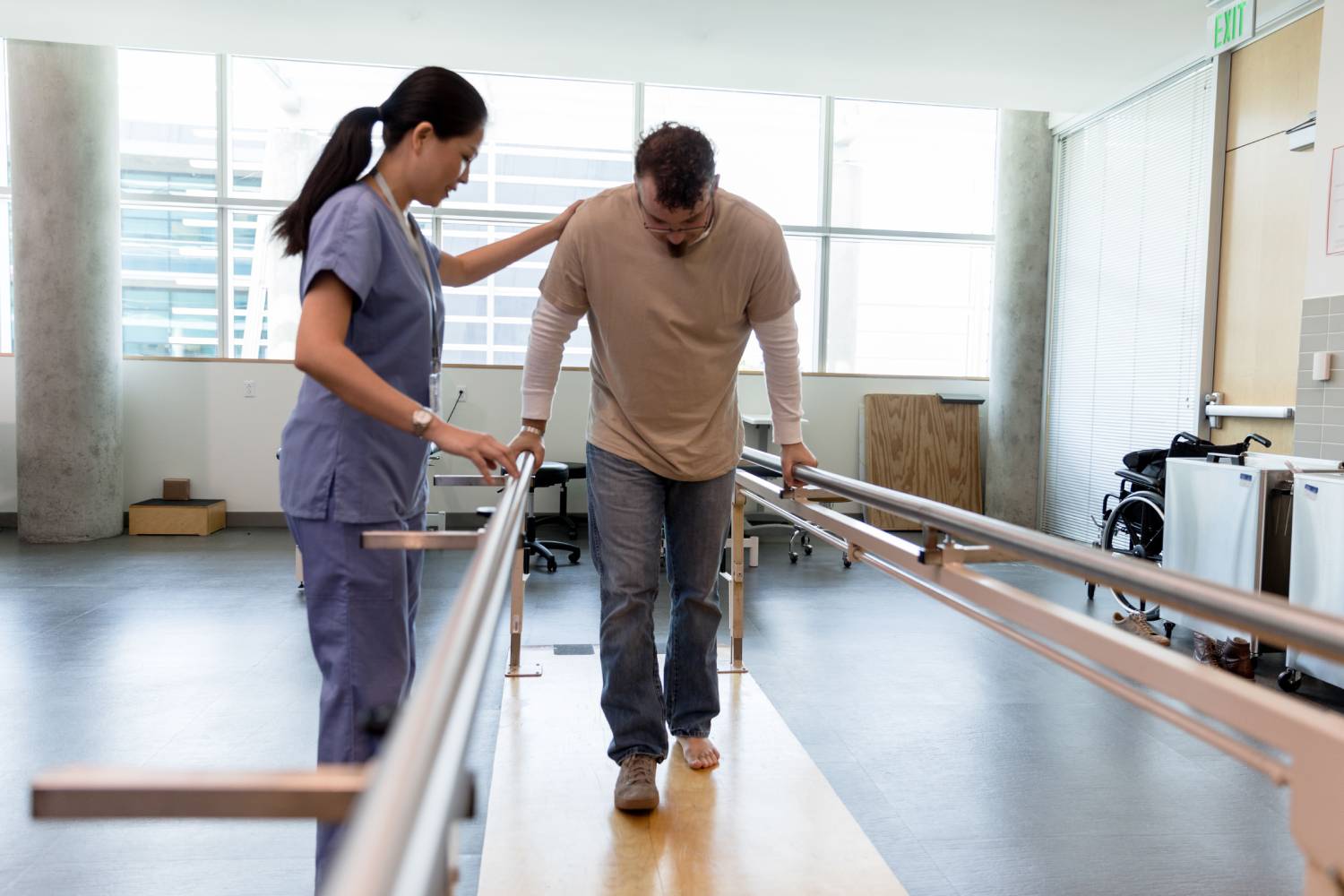The Rehabilitation Process for Severe COVID-19 Patients

Out of the millions of people who have been infected by the novel coronavirus, approximately 20% have been hospitalized [1]. Many of these hospitalized patients have experienced respiratory failure [1]. Beyond pulmonary issues, COVID-19 patients are also susceptible to many other complications, including myocarditis, clotting disorders, and encephalitis [2]. Given how long these patients typically spend in the ICU and the duress of their stays, their time in the hospital must be followed by interdisciplinary rehabilitation for COVID-19 [1].
Several models of rehabilitation for COVID-19 have been proposed. Of course, given the variation in manifestations of the disease, it is difficult to standardize rehabilitative programs [3]. However, some medical professionals agree that the post-COVID-19 rehabilitative process should follow a general sequence: appropriate ICU discharge and ventilator weaning, specialized inpatient treatment, telemedical or home-based rehabilitation, and, finally, specialized outpatient care [4]. During each of the steps, there are a few different types of interventions that are advised, contingent on the individual needs of the patient in question.
Respiratory intervention can be crucial to effective treatment, especially during post-acute rehabilitation [5]. During the acute stage, patients may experience multiple airway obstruction, intrapulmonary exudation, increased respiratory secretions, and atelectasis [3]. When exhibiting such symptoms, hospitalized patients should avoid activities that may contribute to additional pulmonary strain, such as respiratory muscle training, diaphragmatic breathing, and aerobic exercise [5].
During post-acute rehabilitation for COVID-19, some of those prohibited activities are encouraged to strengthen the patient’s pulmonary capability [5]. While remaining careful so as not to over-exert the pulmonary system, patients should be encouraged to partake in diaphragmatic breathing, respiratory muscle training, and pursed-lip breathing [5]. To regularly assess pulmonary status, a speed or short distance walking test can be incorporated into the patient’s routine [3]. Additionally, lung function tests and dynamic lung capacity should be used to assess improvement and make adjustments to a patient’s treatment plan [2].
Another important intervention that should be implemented throughout rehabilitation is physical exertion. Increased severity of COVID-19 has been noted in patients with lifestyle-related diseases, such as obesity and diabetes [1]. Consequently, exercise can not only be an excellent preventative measure but also highly beneficial during rehabilitation [1]. Exercise therapy can benefit patients in a multitude of ways, such as improving cardiovascular function, strengthening the function of noninvolved organs, and augmenting muscle mass [3]. These exercises should include aerobic exertion, resistance movement, and flexibility training [3]. A combination of these practices can combat ICU-related weakness, restore patients’ fitness, and improve cognitive functioning [5, 6].
Psychological treatment is also integral for severe COVID-19 patients, particularly those that may have experienced spinal cord injury, decreased social functioning, or post-traumatic stress disorder [3]. These interventions can take the form of cognitive behavioral therapy, social services, or motivational interviewing [2]. Given that severe illness can often result in the development of psychological disorders such as depression and anxiety, talk therapy can be especially powerful during recovery [6].
In addition to these interventions, other forms of helpful rehabilitation can include speech and language therapy and occupational therapy [1]. Given the increased demands that COVID-19 has placed on the medical system, meeting this demand is an immense challenge [1, 2]. One solution to help counter the current lack of resources is the widespread adoption of telerehabilitation [1]. Given the observed efficacy of telemedicine in rehabilitating stroke patients and the flexibility of telehealth in administering some of the aforementioned treatments, this strategy could answer at least some of the concerns surrounding rehabilitation for COVID-19 [1].
References
[1] A. Salawu et al., “A Proposal for Multidisciplinary Tele-Rehabilitation in the Assessment and Rehabilitation of COVID-19 Survivors,” International Journal of Environmental Research and Public Health, vol. 17, no. 13, July 2020. [Online]. Available: http://doi.org/10.3390/ijerph17134890. [Accessed September 19, 2020].
[2] D.T. Wade, “Rehabilitation after COVID-19: An evidence based approach,” Clinical Medicine, vol. 20, no. 4, p. 356-365, July 2020. [Online]. Available: http://doi.org/10.7861/clinmed.2020-0353. [Accessed September 19, 2020].
[3] B. Zeng et al., “Expert consensus on protocol of rehabilitation for COVID-19 patients using framework and approaches of WHO International Family Classifications,” Aging Medicine, vol. 3, no. 2, p. 82-94, July 2020. [Online]. Available: http://doi.org/10.1002/agm2.12120. [Accessed September 19, 2020].
[4] I. L. Stevens, “New four-stage programme offers rehabilitation for COVID-19 patients in UAE,” August 9, 2020. [Online]. Available: https://insights.omnia-health.com/hospital-management/new-four-stage-programme-offers-rehabilitation-covid-19-patients-uae. [Accessed: September 19, 2020].
[5] L. M. Sheehy, “Considerations for Postacute Rehabilitation for Survivors of COVID-19,” International Journal of Environmental Research and Public Health, vol. 6, no. 2, May 2020. [Online]. Available: http://doi.org/10.2196/19462. [Accessed September 19, 2020].
[6] K. Urban, “Rehabilitation Care is Needed for Many COVID-19 Patients,” July 14, 2020. [Online]. Available: https://labblog.uofmhealth.org/body-work/rehabilitation-care-needed-for-many-covid-19-patients. [Accessed: September 19, 2020].
